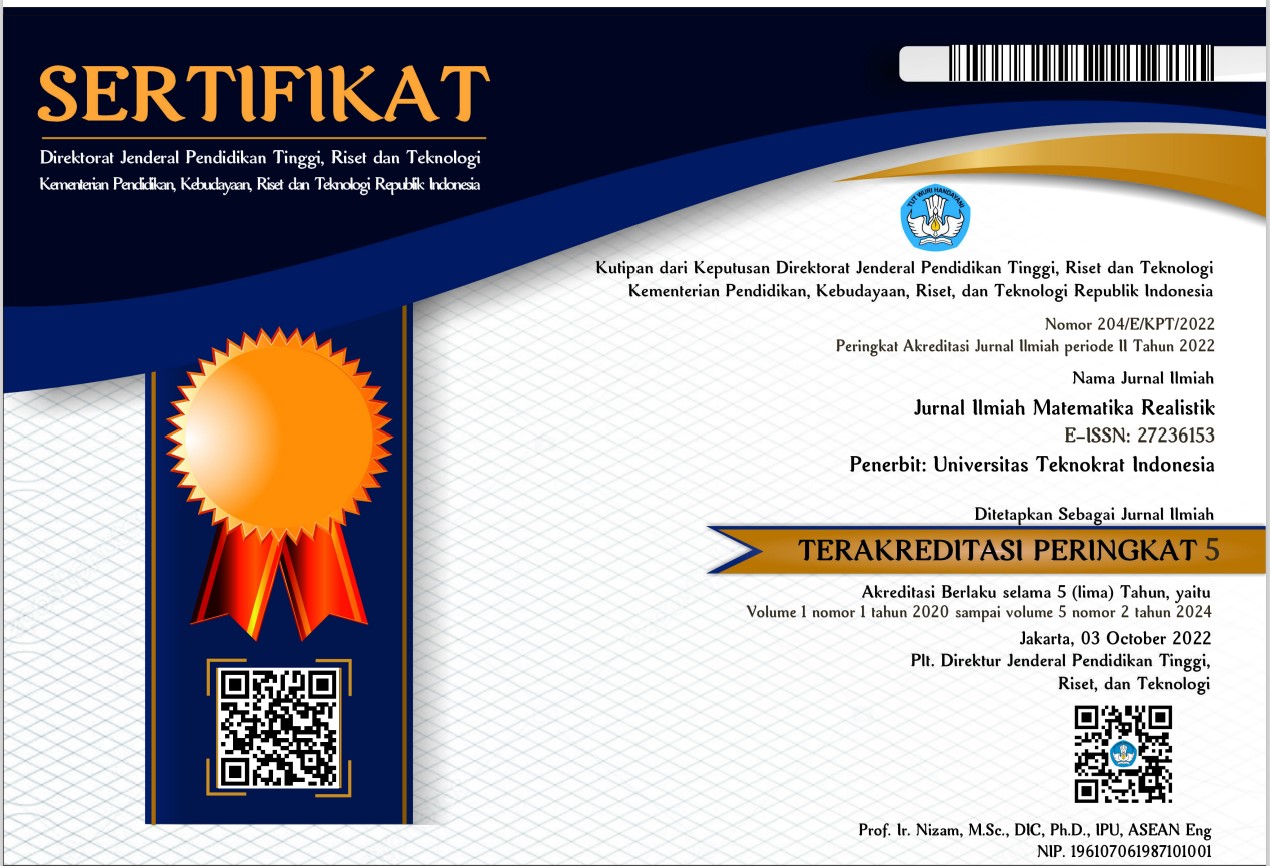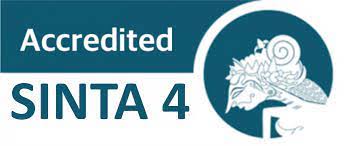A CORRELATIONAL STUDY OF MATHEMATICAL DISPOSITION AND PROBLEM-SOLVING ABILITY IN TRIGONOMETRY
Abstract
This study aims to describe the relationship between mathematical disposition and students’ mathematical problem-solving ability in the topic of trigonometry. The research is grounded on the importance of integrating higher-order thinking skills and positive attitudes toward mathematics in 21st-century learning. A quantitative method with a correlational approach was employed. The research subjects consisted of 20 tenth-grade students from a Madrasah Aliyah in Cimahi City, selected through purposive sampling. The instruments used were a mathematical disposition questionnaire and contextual essay-based problem-solving tests in trigonometry. Data were analyzed descriptively and inferentially using the chi-square test. The results showed that the average students’ problem-solving ability was in the low category with a percentage of 36.09%, while their mathematical disposition was in the moderate category with a percentage of 62.40%. The chi-square test yielded a significance value of 0.757 (p > 0.05), indicating no significant relationship between mathematical disposition and mathematical problem-solving ability. This finding suggests that a positive attitude toward mathematics does not necessarily align with students' ability to solve trigonometric problems. Other factors such as conceptual understanding and learning experiences also play a crucial role. Therefore, mathematics instruction must be holistically designed to foster both cognitive and affective development, supporting students in becoming critical and reflective thinkers.
References
Al-Mutawah, M. A., Thomas, R., Eid, A., Mahmoud, E. Y., & Fateel, M. J. (2019). Conceptual Understanding, Procedural Knowledge and Problem-Solving Skills in Mathematics: High School Graduates Work Analysis and Standpoints. International Journal of Education and Practice, 7(3), 258–273.
Aquino, A. S., & Ibarra, F. P. (2024). Correlational Analysis on Mathematical Disposition and Mathematical Achievement Among Selected Senior High School Students at San Jose City National High School. Journal of Higher Education Theory and Practice, 24(11). https://doi.org/10.33423/jhetp.v24i11.7413
Baroody, A. J. (1993). Problem Solving, Reasoning, and Communicating. Macmillan Publishing.
Brookhart, S. M. (2010). How to Assess Higher-Order Thinking Skills in Your Classroom. ASCD.
DeVellis, R. F. (2017). Scale Development: Theory and Applications (4th ed.). Sage Publications.
Dewi, I. L. K., Zaenuri, Dwijanto, Mulyono, Waluya, S. B., & Rochmad. (2021). Conceptual understanding and productive disposition in trigonometry through generative learning. Journal of Physics: Conference Series, 1918(4), 042050. https://doi.org/10.1088/1742-6596/1918/4/042050
Dinia, S., Nurhafifah, A. Y., Mayasari, M., Patimah, S., & Hidayat, W. (2019). Analisis Kesulitan Kemampuan Pemecahan Masalah Matematis Ditinjau dari Kemampuan Disposisi Matematis Siswa. Journal of Honai Math, 2(1), 65–76. https://doi.org/10.30862/jhm.v2i1.59
Fairus, F., Fauzi, A., & Sitompul, P. (2023). Analisis Kemampuan Disposisi Matematis pada Pembelajaran Matematika Siswa SMKN 2 Langsa. Jurnal Cendekia : Jurnal Pendidikan Matematika, 7(3), 2382–2390. https://doi.org/10.31004/cendekia.v7i3.2549
Gurat, M. (2018). Mathematical Problem-Solving Heuristics Among Student Teachers. Journal on Efficiency and Responsibility in Education and Science, 11(3), 53–64. https://doi.org/10.7160/eriesj.2018.110302
Häkkinen, P., Järvelä, S., Mäkitalo-Siegl, K., Ahonen, A., Näykki, P., & Valtonen, T. (2017). Preparing teacher-students for twenty-first-century learning practices (PREP 21): a framework for enhancing collaborative problem-solving and strategic learning skills. Teachers and Teaching, Taylor & Francis, 23(1), 25–41. https://doi.org/https://doi.org/10.1080/13540602.2016.1203772
Herawaty, D., & Widada, W. (2017). The Influence of Contextual Learning Models and the Cognitive Conflict to Understand Mathematical Concepts and Problems Solving Abilities. Proceedings of the 1st Annual International Conference on Mathematics, Science, and Education (ICoMSE 2017), 96–102. https://doi.org/https://doi.org/10.2991/icomse-17.2018.17
Husna, A., & Hanggara, Y. (2022). An Analysis Of Students’ Problem-Solving Skills Based On Mathematic Disposition During The Covid-19 Pandemic. AL-ISHLAH: Jurnal Pendidikan, 14(4), 5791–5802. https://doi.org/10.35445/alishlah.v14i4.2051
Hutajulu, M., Wijaya, T. T., & Hidayat, W. (2019). The Effect of Mathematical Disposition and Learning Motivation on Problem Solving: an Analysis. Infinity Journal, 8(2), 229. https://doi.org/10.22460/infinity.v8i2.p229-238
Indriyani, I., & Ruqoyyah, S. (2022). Pembelajaran Daring Materi Keliling Bangun Datar untuk Mengukur Kemampuan Pemecahan Masalah Siswa Kelas IV SD Menggunakan Pendekatan Realistic Matematics Education. COLLASE (Creative of Learning Students Elementary Education), 5(4), 748–758. https://doi.org/10.22460/collase.v5i4.8266
Kamid, K., Huda, N., Syafmen, W., Sufri, S., & Sofnidar, S. (2021). The relationship between students’ mathematical disposition and their learning outcomes. Journal of Education and Learning (EduLearn), 15(3), 376–382. https://doi.org/10.11591/edulearn.v15i3.17604
Lomri, Y. A., & Dasari, D. (2024). The Correlation between Mathematical Disposition and Problem Solving in Junior High School Students. Mathema: Jurnal Pendidikan Matematika, 6(1), 65. https://doi.org/10.33365/jm.v6i1.3041
Mahmudi, A. (2010). Tinjauan Asosiasi Antara Kemampuan Pemecahan Masalah Matematis dan Disposisi Matematis. Seminar Nasional Pendidikan Matematika FMIPA UNY, 1–11.
Max, B. (2021). Messages Communicated through Mathematics Content for Elementary Teachers Course Syllabi: A Focus on Mathematical Disposition and Collaboration . Mathematics Teacher Education and Development , 23(2), 4–23.
Maya, R. (2011). Pengaruh Pembelajaran dengan Metode Moore Termodifikasi terhadap Pencapaian Kemampuan Pemahaman dan Pembuktian Matematik Mahasiswa. . Universitas Pendidikan Indonesia.
Maya, R., & Ruqoyyah, S. (2018). The Role of contextual teaching and learning on student’s problem solving ability and disposition. JIML-Journal of Innovative Mathematics Learning, 1(1), 31–40.
Meryansumayeka, M., Susanti, E., Miswanto, A., Putri, R. I. I., & Zulkardi, Z. (2019). Mathematical problem solving tasks in the form of high order thinking skill. Journal of Physics: Conference Series, 1318(1), 012110. https://doi.org/10.1088/1742-6596/1318/1/012110
Muflihatusubriyah, U., Utomo, R. B., & Saputra, N. N. (2021). Analisis Kemampuan Pemecahan Masalah Matematis Siswa Berdasarkan Disposisi Matematis. AlphaMath : Journal of Mathematics Education, 7(1), 49. https://doi.org/10.30595/alphamath.v7i1.9936
OECD. (2019). PISA 2018 Results (Volume I): What Students Know and Can Do. OECD. https://doi.org/10.1787/5f07c754-en
Razak, M., Hakim, F., & AR, R. A. (2022). Analisis Kemampuan Pemecahan Masalah Matematis Siswa Ditinjau dari Kemampuan Disposisi Matematis. J-HEST Journal of Health Education Economics Science and Technology, 4(1), 46–54. https://doi.org/10.36339/jhest.v4i1.65
Rezita, R., & Rahmat, T. (2022). Hubungan Disposisi Matematis dengan Kemampuan Pemecahan Masalah pada Mata Pelajaran Matematika. Lattice Journal : Journal of Mathematics Education and Applied, 2(1), 79. https://doi.org/10.30983/lattice.v2i1.5062
Rivian, D. E., & Hidayati, N. (2023). Analisis Disposisi Matematis Siswa pada Pembelajaran Matematika Materi Persamaan Linear Tiga Variabel. Radian Journal: Research and Review in Mathematics Education, 2(2), 66–75. https://doi.org/10.35706/rjrrme.v2i2.8836
Setiawan, Y. E., & Surahmat. (2023). The Effect of Mathematical Disposition on Basic Mathematical Abilities in the Online Learning. Journal of Education Research and Evaluation, 7(2), 259–266. https://doi.org/10.23887/jere.v7i2.58437
Sugilar, H. (2013). Meningkatkan Kemampuan Berpikir Kreatif Dan Disposisi Matematik Siswa Madrasah Tsanawiyah Melalui Pembelajaran Generatif. Infinity Journal, 2(2), 156. https://doi.org/10.22460/infinity.v2i2.32
Sugiyono. (2019). Metode Penelitian Kuantitatif, Kualitatif, dan R&D. Alfabeta.
Yuliani, I., Kusmayadi, T. A., & Nurhasanah, F. (2021). Deskripsi Kemampuan Pemecahan Masalah Siswa SMP Ditinjau dari Disposisi Matematis. AKSIOMA: Jurnal Program Studi Pendidikan Matematika, 10(2), 1198. https://doi.org/10.24127/ajpm.v10i2.3685
Zhang, L., Zhou, Y., & Wijaya, T. T. (2020). Hawgent dynamic mathematics software to improve problem-solving ability in teaching triangles. Journal of Physics: Conference Series, 1663(1). https://doi.org/10.1088/1742-6596/1663/1/012069









